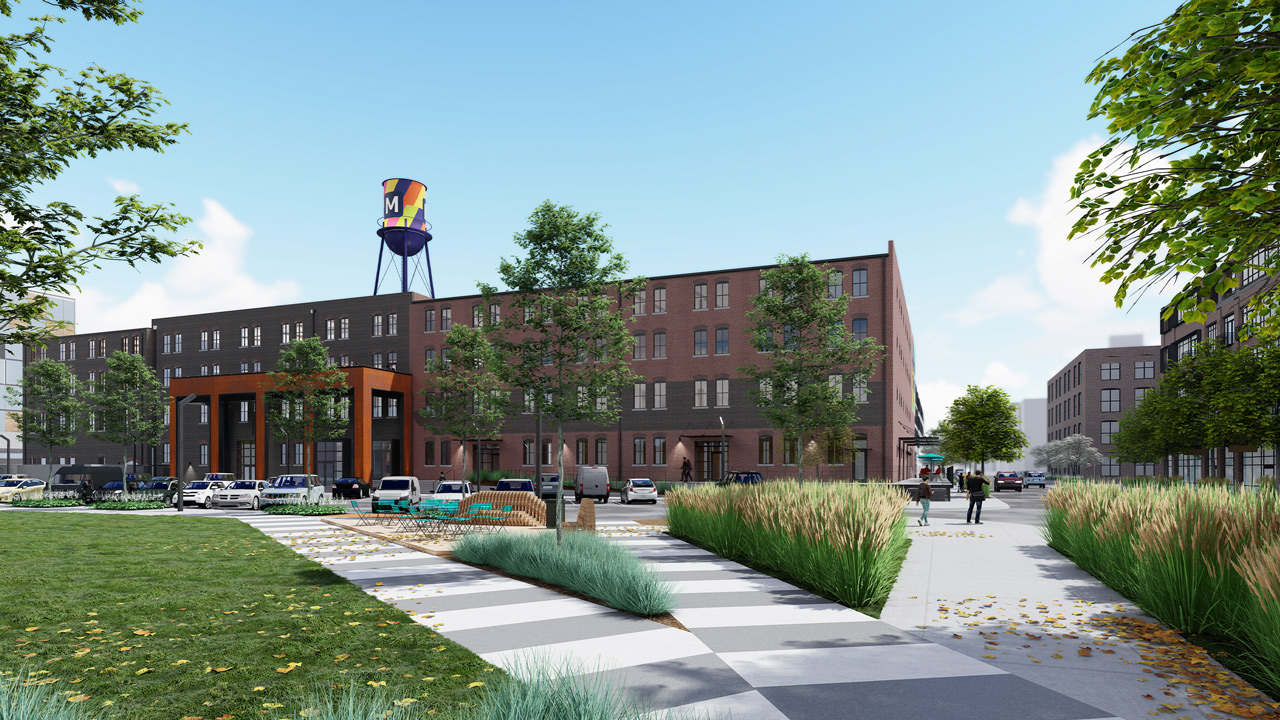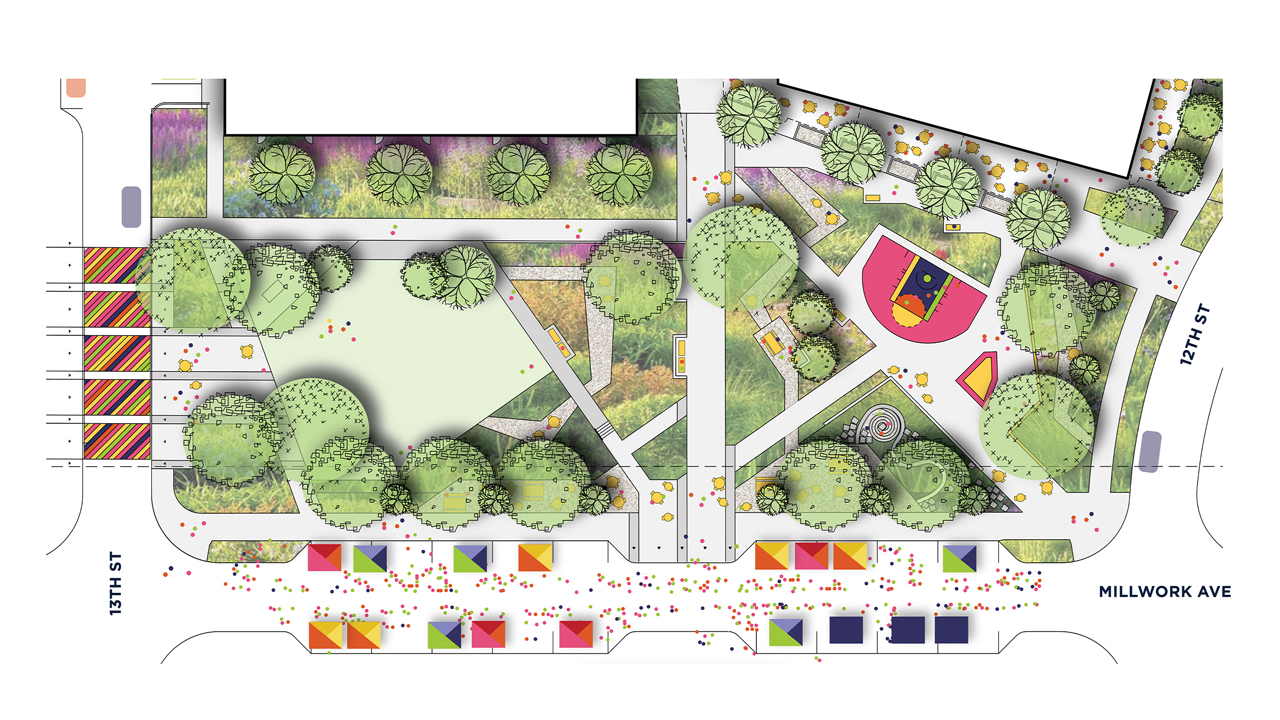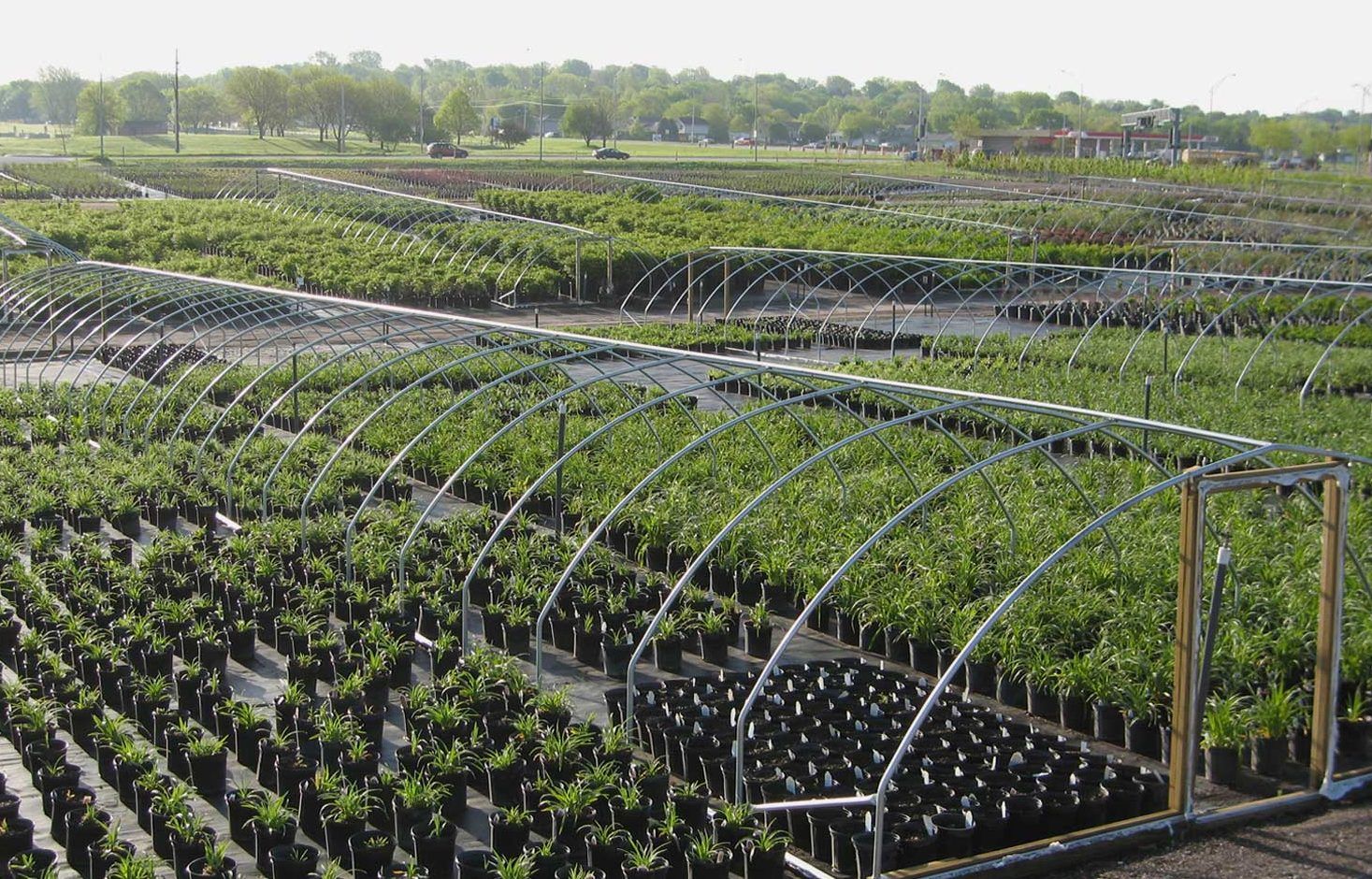
For more than 60 years, we’ve poured our passion for our community into creating lasting landscapes that inspire and support a healthier city for generations to come. But few projects have brought as much excitement to our entire team as the one taking place now at Millwork Commons.
For us, it’s an example of the hope we have for our community, the planet, and our ability to impact both in a positive and meaningful way.
In the new revitalization project in North Downtown Omaha, plantings inspired by our local, natural landscapes will play a key part in the design. And we’re excited to be a part of it, working alongside leading landscape architects, growing thousands of native plants for the project, and installing and maintaining what we believe will be an iconic landscape here in Omaha.
Image by The Olsson Studio

Image by Alley Poyner Macchietto Architecture
The project – led by Black Dog Management in partnership with Alley Poyner Macchietto Architecture and Olsson – covers fifty acres near 13th and Nicholas Streets and will offer a pedestrian-friendly space for today’s visionaries in art, technology, and design, with a diverse mix of housing, businesses, and green spaces.
Architect Megan Lutz says one element of the project is to use green infrastructure to help meet their goals of sustainability, walkability, cohesiveness, and safety. Plantings of trees, shrubs, and perennials will provide shade for gathering places, define and beautify walkways, calm traffic and dampen its noise, and serve as natural stormwater mitigation.
Inspired in part by Lurie Garden in Chicago’s Millennium Park and Nebraska’s prairies, woodlands, and riparian landscapes, the design includes large swaths of color, largely made up of native perennials, as well as a mix of native trees and shrubs. Not only will it offer a natural oasis in the middle of an urban, industrial landscape, but the diversity of native plants will be a haven for wild pollinators, birds, and other local wildlife.

Image by Alley Poyner Macchietto Architecture
As Kayla Meyer, one of the landscape architects leading the planting design, explains, “The organization of the colored perennial swaths started with an overlay of the map of Nebraska and tracing our prominent waterways – Platte River and Missouri River.”
This is the inspiration behind flowing masses of blue blooms – including pitcher sage, bottle gentian, and baptisia – symbolizing water and wind.
According to Kayla, “The green is to represent our indigenous plants and prairies and are swaths mostly made of native grasses. Everything else started to evolve from there to create an aesthetically pleasing plan and experience.”
In another grouping, you’ll see shades of pink and red with plants like swamp milkweed, joe pye weed, and various coneflowers representing agriculture. And masses of orange and gold wildflowers like goldenrod, compass plant, and butterfly milkweed represent industrial areas.
In cooperation with her colleague, Mark Canney, Kayla created the initial plant list, which evolved through the project. “Combined with Mulhall’s native plant experience, we were able to work together to create a final plant list that relies on a collection of native perennial staples and re-introduce some new ones.”
“I’m mostly excited to see it installed and be able to visit and watch it evolve over the years. Many of the plants are not typical for a commercial install, so it’s very exciting to take this type of approach for a project on such a large scale,” Kayla says.


As part of the earliest stages of the project, our team took an extreme approach to urban tree-planting along the north side of the historic Ashton Building. Using a special underground system that supports stronger root growth, the goal is to make sure these shade trees live a long, healthy life. And we’re excited to say it’s the first of its kind here in Omaha – with more planned for the project later this year.
Now, with the larger plantings coming as early as this fall, our team of growers is preparing with plans to grow the majority of plants needed – including more than 4,000 perennial plants representing dozens of native prairie species.
As Hannah Robertson, Nursery Stock Grower here at Mulhall’s Farms shares, “The natural world has always excited me. Visiting Hitchcock Nature Center, exploring the trails, and recognizing native species that we’re growing for the Millwork project, that excites me even more!”

As our Farms team works to expand the collection of native plants at our store, the project was a natural fit. “Growing the natives for Millwork has certainly fast-forwarded our momentum on how we can do better, and we’re thrilled to work with like-minded teams like Olsson,” Hannah says.
In addition to growing a lot more native plants for our community, our Farms team continues to focus on better supporting the natural world in other ways too: using less harmful chemicals and introducing a natural refuge on our property for beneficial insects to thrive.
But even more so than a traditional landscape project, the plantings at Millwork Commons will take time. As Mike Mladenoff, Senior Field Manager here at Mulhall’s Landscape, says, “I don’t want anyone to think come next spring it’s going to be this lush, dense prairie. It’s going to take some time for everything to really get established. But I can’t wait to see it a few years from now when there’s this beautiful prairie landscape in the middle of this urban, industrial area.”
And it’s not just Millwork Commons that’s bringing a change to our urban landscape. It’s a trend we’re excited to see gaining impressive momentum.
“Three years ago, it was the gardening enthusiast with 80 different species in their backyard, and that was about it,” Mike says.

“But now we’re seeing the interest in native plants everywhere, even with these big commercial jobs that come through for bids on installation. We’re seeing it switch from daylilies and ‘Karl Forester’ grass to now a lot of coneflower, aster, and liatris. There’s also black-eyed-Susan, baptisia, panicum, and a bunch of different carex.”
For us, it’s all about connecting our community with the natural world, celebrating nature here in our city, and growing the conversation about its preservation. And we couldn’t be more excited to be a part of the project at Millwork Commons and other nature-inspired landscapes that’ll continue to impact our community in the years to come.
To learn more about how you can help the planet right in your own landscape, stop in and talk with our team!


